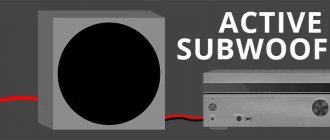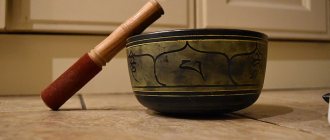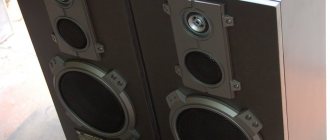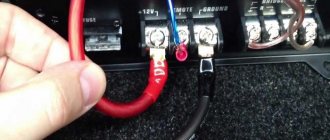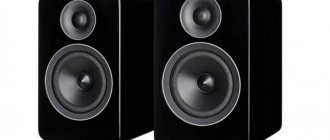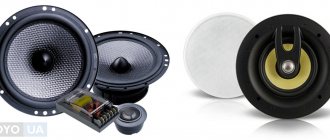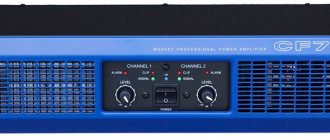<< Read previous part
Now you should take care of the “heart” of the subwoofer - the dynamic head. I’ll warn you right away - what it looks like, the size of the magnet and other visual parameters do not interest us at all (especially since it won’t be visible), only the dimensions. But factors that influence the sound, for example, the Thiel-Small parameters (a set of electroacoustic parameters that determine the behavior of the speaker in the low frequency range) will be very useful to us.
We will talk about what is really important to know about acoustics. Namely, about the famous Thiel-Smol parameters.
Who had the honor of bearing the names of Thiel and Small's parameters? Let's remember this too. The first in the bunch is Albert Neville Thiele (in the original A. Neville Thiele, “A” is almost never deciphered). Both by age and bibliography. Thiel is now 84 years old, and when he was 40, he published a landmark paper that pioneered the ability to calculate loudspeaker performance using a single set of parameters in a convenient and repeatable manner.
There, in a 1961 paper, it was said, in part, “The low-frequency performance of a loudspeaker can be adequately described by three parameters: the resonant frequency, the volume of air equivalent to the acoustic flexibility of the loudspeaker, and the ratio of electrical resistance to resistance to movement at the resonant frequency The same parameters are used to determine electroacoustic efficiency. I encourage loudspeaker manufacturers to publish these parameters as part of the basic information about their products."
Neville Thiel's request was heard by the industry only a decade later, at which time Thiel was already working with Richard Small, a native of California. Richard Small is spelled in Californian, but for some reason the respected doctor prefers the German pronunciation of his own name. Small turns 70 this year, which, by the way, is a more important anniversary than most. In the early seventies, Thiel and Small finally finalized their proposed approach to calculating loudspeakers.
Neville Thiel is now a professor emeritus at a university in his home country of Australia, and Dr. Small's last professional position that we were able to track was as chief engineer of Harman-Becker's automotive audio department. And, of course, both are members of the leadership of the International Society of Acoustic Engineers (Audio Engineering Society). In general, both are alive and well.
Thiel on the left, Small on the right, in order of contribution to electroacoustics. By the way, the photo is rare, the masters did not like to be photographed
Impedance of car and home speakers
The most significant difference between car speakers and home theater speakers is the impedance rating. Speaker impedance is the electrical load that the speaker places on the amplifier. Specifically, it is a measure of the speaker's resistance to amplifier current.
When you measure resistance or impedance, you measure it in ohms.” The most common analogy to explain impedance is to compare it to running water. The more resistance, or the higher the resistance, the less water or electrical current can pass through. If the resistance is too high, the current will build up and the amplifier will burn out.
Check out our article that explains all the features of home theater speakers!
Differences between car and home speakers
Car speakers will most likely have an impedance of 4 ohms, while your home theater speakers will have an impedance of 8 ohms. It is extremely rare for car speakers to have a resistance of more than 4 ohms. There are several reasons for this.
A car battery typically produces 12 to 14 volts, compared to a home outlet that produces about 110 volts. Because of this, the amplifier in your car will usually be low voltage and high amperage rated. As you might expect, the amplifiers in your home will most likely be the exact opposite - low-amp and high-voltage.
Since your car has lower voltage, the speakers will need less resistance to produce the required power. An amplifier that can deliver 50 watts of power into 8 ohms will be able to deliver 75 or 100 watts of power into 4 ohms because the current is less limited. For this reason, most companies design car amplifiers specifically for 4 ohm speakers.
As you might expect, the opposite is true for home speakers. Since your household outlets offer much higher voltage, a smaller percentage of it is required to be transmitted to the speaker, and will likely have a higher impedance rating. There are 4 ohm home theater speakers, but car speakers rarely have a higher impedance than 4 ohms.
SECOND MAP, NOT MEASURED IN ANYTHING
The brake power of a speaker is expressed numerically in the second Thiel-Small . This is the total quality factor of the speaker, designated Qts. Expressed numerically, but not literally. I mean, the more powerful the brakes, the lower the Qts value. Hence the name “quality factor” in Russian (or quality factor in English, from which the designation of this quantity originated), which is, as it were, an assessment of the quality of the oscillatory system. Physically, the quality factor is the ratio of elastic forces in a system to viscous forces, otherwise - to friction forces. Elastic forces store energy in the system, alternately transferring energy from potential (a compressed or stretched spring or speaker suspension) to kinetic (the energy of a moving diffuser). Viscous ones strive to turn the energy of any movement into heat and irrevocably dissipate. A high quality factor (and for the same bell it will be measured in tens of thousands) means that there are much more elastic forces than frictional forces (viscous, these are the same thing). This also means that for each oscillation only a small part of the energy stored in the system will be converted into heat. Therefore, by the way, quality factor is the only value in the three Thiel-Small parameters that does not have a dimension; it is the ratio of one force to another. How does a bell dissipate energy? Through internal friction in bronze, mainly slowly. How does a speaker do this, whose quality factor is much lower, and therefore the rate of energy loss is much higher? In two ways, depending on the number of “brakes”. Part is dissipated through internal losses in the elastic elements of the suspension, and this share of losses can be estimated by a separate value of the quality factor, it is called mechanical, denoted Qms. The second, larger part is dissipated in the form of heat from the current passing through the voice coil. The current produced by her. This is the electrical quality factor Qes. The total effect of the brakes would be determined very easily if it were not the values of the quality factor, but, on the contrary, the values of losses that were used. We would just fold them. And since we are dealing with quantities that are the reciprocals of losses, then we will have to add the reciprocal quantities, which is why it turns out that 1/Qts = 1/Qms + 1/Qes.
Typical values of quality factor: mechanical - from 5 to 10. Electrical - from 0.2 to 1. Since inverse values are involved, it turns out that we sum up the mechanical contribution to losses of the order of 0.1–0.2 with the electrical contribution, which is from 1 to 5. It is clear that the result will be determined mainly by the electrical quality factor, that is, the main brake of the speaker is electric.
So how do you snatch the names of the “three cards” from the speaker? Well, at least the first two, we'll get to the third. The same voice coil, the fiery speaker motor, comes to the rescue. After all, we have already realized: a flame motor also works as a flame generator. And in this capacity, it seems to be sneaking about the amplitude of vibrations of the diffuser. The greater the voltage appears on the voice coil as a result of its oscillations together with the diffuser, the greater the range of oscillations, which means the closer we are to the resonant frequency.
How to measure this voltage, given that a signal from the amplifier is connected to the voice coil? That is, how to separate what is supplied to the motor from what is generated by the generator, is it on the same terminals? You don’t need to divide, you need to measure the resulting amount.
This is why they do this. The speaker is connected to an amplifier with the highest possible output impedance; in real life, this means: a resistor with a value of much, one hundred, at least, times the nominal resistance of the speaker is connected in series with the speaker. Let's say 1000 ohms. Now, when the speaker is operating, the voice coil will generate a back-EMF, sort of like for the operation of an electric brake, but braking will not occur: the coil leads are closed to each other through a very high resistance, the current is negligible, the brake is useless. But the voltage, according to Lenz’s rule, is opposite in polarity to the supplied one (“generating movement”), will be in antiphase with it, and if at this moment you measure the apparent resistance of the voice coil, it will seem that it is very large. In fact, in this case, the back-EMF does not allow the current from the amplifier to flow unhindered through the coil, the device interprets this as increased resistance, but what else?
By measuring the impedance, that very “apparent” (but in fact complex, with all sorts of active and reactive components, now is not the time to talk about that) resistance, two cards out of three are revealed. The impedance curve of any cone speaker, from Kellogg and Rice to the present day, looks, in principle, the same, it even appears in the logo of some electroacoustic scientific community, I forget which one now. The hump at low (for this speaker) frequencies indicates the frequency of its fundamental resonance. Where there is a maximum, there is the coveted Fs. It couldn't be more elementary. Above resonance there is a minimum impedance, which is usually taken as the nominal impedance of the speaker, although, as you can see, it remains this way only in a small frequency band. Higher up, the total resistance begins to increase again, now due to the fact that the voice coil is not only a motor, but also an inductance, the resistance of which increases with frequency. But we won’t go there now; the parameters that interest us don’t live there.
It is much more complicated with the value of the quality factor, but, nevertheless, comprehensive information about the “second card” is also contained in the impedance curve. Comprehensive, because from one curve you can calculate both the electrical Qes and the mechanical quality factor Qms, separately. We already know how to then make a complete Qts out of them, which is really necessary when calculating the design; it’s a simple matter, not a Newton binomial.
We will discuss exactly how the required values are determined from the impedance curve another time, when we talk about methods for measuring parameters. Now we will assume that someone (the speaker manufacturer or the associates of your humble servant) did this for you. But I will note this. There are two misconceptions associated with attempts to expressly analyze the Thiel-Small parameters based on the shape of the impedance curve. The first is completely bogus, and we will now dispel it without a trace. This is when they look at the impedance curve with a huge hump at resonance and exclaim: “Wow, good quality!” Kind of high. And looking at the small bump on the curve, they conclude: since the impedance peak is so smooth, it means that the speaker has high damping, that is, a low quality factor.
So: in the simplest version, it’s exactly the opposite. What does a high impedance peak at resonance frequency mean? That the voice coil produces a lot of back-EMF, designed to electrically brake the oscillations of the cone. Only with this connection, through a large resistance, the current necessary for the operation of the brake does not flow. And when such a speaker is turned on not for measurements, but normally, directly from the amplifier, the braking current will flow, be healthy, the coil will become a powerful obstacle to the excessive oscillations of the diffuser at its favorite frequency.
All other things being equal, you can roughly estimate the quality factor from the curve, and remembering: the height of the impedance peak characterizes the potential of the speaker's electric brake, therefore, the higher it is, the LOWER the quality factor. Will such an assessment be exhaustive? Not exactly, as was said, she will remain rude. Indeed, in the impedance curve, as already mentioned, information about both Qes and Qms is buried, which can be dug out (manually or using a computer program) by analyzing not only the height, but also the “shoulder width” of the resonant hump. In this regard, we have carried out several computational experiments here; if you are interested, take a look.
And how does the quality factor affect the shape of the speaker’s frequency response? This is what interests us, isn’t it? How it affects - it has a decisive impact. The lower the quality factor, that is, the more powerful the internal brakes of the speaker at the resonant frequency, the lower and more smoothly the curve will pass near the resonance, characterizing the sound pressure created by the speaker. The minimum ripple in this frequency band will be at Qts equal to 0.707, which is commonly called the Butterworth characteristic. At high Q values, the sound pressure curve will begin to “hump” near resonance, it’s clear why: the brakes are weak.
Is there a “good” or a “bad” total quality factor? By itself, no, because when the speaker is installed in an acoustic design, which we will now consider only a closed box, both its resonance frequency and overall quality factor will become different. Why? Because both depend on the elasticity of the speaker suspension. The resonant frequency depends only on the mass of the moving system and the rigidity of the suspension. As stiffness increases, Fs increases, and as mass increases, it decreases. When the speaker is installed in a closed box, the air in it, which has elasticity, begins to act as an additional spring in the suspension, the overall rigidity increases, Fs increases. The total quality factor also increases, since it is the ratio of elastic forces to braking forces. The brake capabilities of the speaker will not change from installing it to a certain volume (why would it?), but the total elasticity will increase, the quality factor will inevitably increase. And it will never become lower than the “naked” dynamics. Never, this is the lower limit. How much will all this increase? And this depends on how rigid the speaker’s own suspension is. Look: the same value of Fs can be obtained with a light diffuser on a soft suspension or with a heavy one on a hard suspension; mass and stiffness act in opposite directions, and the result may turn out to be numerically equal. Now if we place a speaker with a rigid suspension in some volume (which has the elasticity required for this volume), then it will not notice a slight increase in the total stiffness, the values of Fs and Qts will not change much. Let’s put a speaker with a soft suspension there, in comparison with the stiffness of which the “air spring” will already be significant, and we will see that the total stiffness has changed significantly, which means that Fs and Qts, initially the same as those of the first speaker, will change significantly.
In the dark “pre-Tile” times, in order to calculate new values of the resonance frequency and quality factor (they, in order not to be confused with the parameters of the “bare” speaker, are designated as Fc and Qtc), it was necessary to know (or measure) directly the elasticity of the suspension, in millimeters per newton of applied force , know the mass of the moving system, and then play tricks with calculation programs. Thiel proposed the concept of “equivalent volume,” that is, a volume of air in a closed box whose elasticity is equal to the elasticity of the speaker suspension. This value, designated Vas, is the third magic card.
Differences in car and home subwoofers
The most obvious difference between car subwoofers and those used for home theaters is size. Not only is the speaker cabinet sized to accommodate a more powerful subwoofer, it is also necessary if the subwoofer will be active.
An active subwoofer is a subwoofer that has an internal amplifier built into it. It doesn't have to rely on a stereo amplifier for power, so it has a lot of flexibility and can be much more powerful.
Active subwoofers, because they have their own amplifier, also need their own power supply. The easiest way to tell if your home theater subwoofer is active is to determine whether it needs to be plugged in. Passive subwoofers only need to be connected to an amplifier. Powered subwoofers require an outlet.
As you can imagine, the subwoofer in your car will be passive - unless you really put in the effort to do something active. When you hear bass coming from a passing car 3 blocks away, you can be sure they installed a powered subwoofer.
The difference in size also results in a difference in the efficiency of the two subwoofers. The subwoofer in your home is designed to move large amounts of air and produce sound over a large area. The subwoofer in your car is designed to fill the car's interior with sound, taking up much less space.
CARD ONE, MEASURED IN HERTZ
So: Thiel-Small parameter No. 1 is the speaker’s own resonant frequency. It is always designated Fs, regardless of the language of publication. The physical meaning is extremely simple: since the speaker is an oscillating system, it means there must be a frequency at which the diffuser will oscillate when left to its own devices. Like a bell after being struck or a string after being plucked. This means that the speaker is absolutely “naked”, not installed in any housing, as if hanging in space. This is important because we are interested in the parameters of the speaker itself, and not of what surrounds it.
The range of frequencies around the resonant one, two octaves up, two octaves down - this is the area where the Thiel-Small parameters operate. For subwoofer heads that have not yet been installed in the housing, Fs can range from 20 to 50 Hz, for midbass speakers from 50 (bass “sixes”) to 100–120 (“fours”). For diffuser midrange drivers - 100–200 Hz, for dome ones - 400–800, for tweeters - 1000–2000 Hz (there are exceptions, very rare).
How is the natural resonant frequency of a speaker determined? No, as is most often defined - clearly, read in the accompanying documentation or in the test report. Well, how was she initially recognized? It would be easier with a bell: hit it with something and measure the frequency of the buzz produced. The speaker will not hum explicitly at any frequency. That is, he wants to, but the damping of diffuser vibrations inherent in his design does not allow him to do so. In this sense, the speaker is very similar to a car suspension, and I have used this analogy more than once and will continue to do so. What happens if you rock a car with empty shock absorbers? It will swing at least a few times at its own resonant frequency (where there is a spring, there will be a frequency). Shock absorbers that are only partially dead will stop the oscillations after one or two periods, while those that are in good working order will stop after the first swing. In dynamics, the shock absorber is more important than the spring, and here there are even two of them.
The first, weaker one, works due to the fact that energy is lost in the suspension. It is no coincidence that the corrugation is made from special types of rubber; a ball made of such material will hardly bounce off the floor; a special impregnation with high internal friction is also chosen for the centering washer. This is like a mechanical brake of diffuser vibrations. The second, much more powerful, is electric.
Here's how it works. The speaker's voice coil is its motor. An alternating current flows through it from the amplifier, and the coil, located in a magnetic field, begins to move with the frequency of the supplied signal, moving, of course, the entire moving system, then it is here. But a coil moving in a magnetic field is a generator. Which will generate more electricity the more the coil moves. And when the frequency begins to approach the resonant one, at which the diffuser “wants” to oscillate, the amplitude of the oscillations will increase, and the voltage produced by the voice coil will increase. Reaching a maximum exactly at the resonant frequency. What does this have to do with braking? None yet. But imagine that the coil leads are connected to each other. Now a current will flow through it and a force will arise, which, according to Lenz’s school rule, will impede the movement that generated it. But in real life the voice coil is closed to the output impedance of the amplifier, which is close to zero. It turns out like an electric brake that adapts to the situation: the more the diffuser tries to move back and forth, the more the counter current in the voice coil prevents this. The bell has no brakes, except for the damping of vibrations in its walls, and in bronze - what damping...
Car and home speaker design
Manufacturers design car speakers for a completely different environment than home speakers—in many ways. A lot happens inside your car - temperature changes, severe frosts, high humidity, the heat of the sun.
Your home theater speakers will obviously live in your home. Since your home is likely soft and climate-controlled, it doesn't necessarily need to be that durable. This allows for greater flexibility in aesthetic design and other features. This design choice will not expose the speaker to the risk of failure due to exposure to the elements.
When you look at car speakers and home speakers, you will notice that they are completely different. However, if you were to remove the home speakers from their cabinets, they might look about the same.
Car speakers are usually built directly into the car in one way or another. This means there is no car speaker enclosure, just bare parts with a grille or cover. Of course, there are exceptions to this rule, mainly when building powerful speaker systems into the trunk of a car.
How to choose a speaker for a subwoofer?
How to choose a speaker for a subwoofer?
If you are faced with such a question, then I would venture to suggest that you are not yet an experienced saber builder. I will try to give you the simplest and most reliable recommendations for choosing a speaker for your future car subwoofer.
Let's start with the simple. Now we will not consider the issues of linking a subwoofer to a specific car, to its front speakers, to a power amplifier, etc. Let's assume that all these issues have already been resolved. At the moment, our task is to choose a speaker that is exactly suitable for a closed box and/or bass reflex.
To avoid making a mistake, you need to know some speaker parameters before purchasing. Well, in fact, you can’t choose only by appearance! The speaker must first of all sound.
But its ability to sound is determined by a handful of parameters that reputable manufacturers usually indicate in the speaker’s passport. Right now and for a long time, we will make it a habit not to hang out with indecent people. There are no Thiel-Small dynamics parameters in the passport - that’s it, the audience is over. Next! And only so.
When you become a pro and can measure Thiel-Small’s parameters yourself, then there will be a different conversation. And now we are not playing blindly with the manufacturer.
Here are the parameters we will need to know:
Fs is the frequency of the main resonance of the moving system, expressed in Hertz Vas is the equivalent volume, usually given in liters Qts is the total quality factor, a dimensionless quantity. BL – the force of the “motor”, that is, the force of the magnetic system Mms – the mass of the moving dynamic system in grams Sd – the effective area of the cone in square centimeters Xmax – the maximum stroke of the cone in one direction in millimeters.
Seven parameters is not so much. The last two are not particularly critical, but it makes sense to take them into account, more on that later.
Let's go through the entire chain. I will now list the parameters and give extreme values for them. When choosing a speaker, you simply look through its parameters so that they fit within the acceptable interval that I will indicate. Some parameter doesn’t fit – we adjust the dynamics for this. Next! You, of course, are free not to listen to me and act in your own way, but then I cannot guarantee that you will achieve something worthwhile. Don’t ask later why you can’t get an acceptable sound from the subwoofer.
So,
Fs should be no higher than 35-36 Hz Vas for 10″ - 25...45l, for 12" - 30...60l, for 15" - 50...80 liters Qts should have a value from 0.35 to 0.55 BL and Mms should be consider only in conjunction: calculate the ratio BL/Mms. It must be greater than 0.08.
For example, we have BL=22, Mms=229g. Then the ratio BL/Mms=22/229=0.096. Good.
And if the moving mass were greater, for example, 300g, then the ratio would be 22/300 = 0.073 - not satisfied, we are looking for another speaker.
Finally, the last couple of parameters.
Sd is the effective area of the cone. For 10-inchers it usually reaches 340-350 sq.cm. For 12" heads, Sd is about 490 sq.cm. For the “tags”... well, look in the passport for yourself, if anything.
Xmax – maximum cone travel in one direction. You will laugh, but there are subwoofers that have indecently short strokes. Don't believe me? Then look at the data on the Sony XS-L1220R, where the Xmax is only 3 millimeters. We don’t need such subs, that’s for sure. Like the volume of the box - so give it to them, but how to play, so they are not there! Friends, we don’t even consider Xmax less than 8 mm in one direction.
So, if we multiply Sd by Xmax, we get a value called volumetric displacement. It indirectly characterizes the maximum volume that can be obtained from the speaker. This means that you can also select a speaker based on volumetric displacement!
Look: for example, a neighbor has a “twelve”, with Sd=490, Xmax=10. But our box doesn’t fit in two. Let's say you need to carry a baby stroller or whatever else in the trunk... In short, we can only fit a 10-incher. No problem. If we take a 10-incher with a maximum stroke of 20 mm, we will outshine our neighbor.
In fact, our neighbor has a volumetric displacement of 490x1=490 cc, and ours has 340x2=680 cc!
Our “ten” can move a larger volume of air per unit time and create greater sound pressure. Of course, all this is “other things being equal.”
Here are my recommendations for beginners in choosing a speaker for a car subwoofer. If you stick to them, you definitely won’t make a big mistake.
Next, it’s a matter of designing the acoustic design. But that's a completely different story.
(c) Evgeniy Mitskevich
The article was published with the permission of the author, and you can also visit the author’s useful website https://www.bassport.net/
Related questions
Which is better, an 8 ohm speaker or a 4 ohm speaker?
The best speaker in any scenario depends on the amplifier you connect it to.
4 ohm speakers have an impedance of 4 ohms. 8 ohm speakers have an impedance of 8 ohms. This means that the power current that the amplifier carries can flow more freely through a 4 ohm speaker than through an 8 ohm speaker. This measure is called "impedance".
Lower impedance means higher current at a given voltage. A 4 ohm speaker requires more power from the amplifier than an 8 ohm speaker at the same volume. If the amp is rated for 8 ohm speakers, 4 ohm speakers can push the volume to the max to get decent sound.
You can double up and connect two 4 ohm speakers to one 8 ohm terminal to create an 8 ohm impedance. It won't necessarily give you better results than an 8 ohm speaker.
A selection of low-frequency speakers up to 10″ in size for a DIY subwoofer from Aliexpress
Today's post is about woofers for DIY audio projects. In particular, let's look at the speakers on which you can build a homemade subwoofer for your home. We will rank the speakers according to the size of the diffuser, up to 10″. Moreover, we will consider even small options for portable and desktop systems.
For a woofer that will play the very bottom of the sound range, there are a number of parameters that you need to pay attention to.
- Low resonant frequency
- Wide suspension providing large linear travel of the diffuser
- Powerful magnetic system
- Overall quality factor (Qts), suitable for typical acoustic designs (closed box and bass reflex)
To accurately calculate the acoustic design and dimensions of the housing in a future project, it is necessary to use computer programs. I recommend the popular one - bassbox 6 pro.
SW-301
Find out the price
The selection opens with a 3" woofer with a woven fiberglass cone and a shielded magnetic system. Of course, the use of a speaker in such a tiny caliber is quite limited - it can be used in portable or compact desktop solutions as a woofer or full-frequency speaker. Even despite the high quality factor, 100 Hz can be achieved with thoughtful design.
There is a detailed review for this speaker with measurements of all parameters.
The lot has a choice of: flange type (rectangular or round), DC resistance 4/8 Ohm. Fast delivery from a warehouse in the Russian Federation is also available.
HKNA 3.5″
Find out the price
Next, a rather interesting option in the size of 3.5″ 30 W (again for ultra-compact systems). The outer diameter of the flange is 95 mm, there is a neoprene seal.
Key Features:
- Neodymium magnetic system
- Wide rubber suspension
- Low resonance 60 Hz
- Separate coil outlet for EMOS
Delivery from China, you can choose one or a pair of speakers.
KYYSLB 4″
Find out the price
4″ is already a borderline size; it can be used in large portable boomboxes, homemade sound bars and computer systems 2.1 The speaker has a power of 40 W and an outer flange diameter of 116 mm. Stamped steel basket.
This option from KYYSLB has a high wide suspension, a low resonant frequency (70 Hz) and a convenient universal quality factor of 0.48.
In the lot you can choose a resistance of 4 or 8 ohms.
4.5″ from Apple HomePod
Find out the price
Powerful 50 W 4.5″ speaker, the same one used in the Apple HomePod speaker. Why not use it for your DIY project. Resistance 4 Ohms, product weight 1.3 kg.
Key Features:
- Powerful magnetic system with ventilated core
- Aluminum composite diffuser
- Wide rubber suspension
Among the shortcomings is the non-standard flange, but it can be covered with an overlay.
GHXAMP 5.25″
Find out the price
The 5″ caliber is often used in subwoofers and sets of computer acoustics 2.1. The volume of the housing is not burdensome in size. The option from GHXAMP is quite versatile; it can be used as a speaker for a subwoofer and as a low-frequency link in two-way acoustics. Resistance 4 Ohm, power 60 W, powerful cast basket.
Basic parameters and graphs are shown on the lot page. Main three: resonance 55 Hz, equivalent volume 10 l, quality factor Qts 0.32.
Delivery from China. If you need a speaker with an impedance of 8 ohms (less preferable for a subwoofer), you need to write a message to the seller.
GHXAMP 6.5″
Find out the price
Another option from GHXAMP, only this one has a good size of 6.5″, an aluminum cast basket and a composite diffuser. 50 W power, coil diameter 30 mm, 4 Ohm DC resistance.
The speaker is quite universal in use (subwoofer, car, DIY two-way acoustics), parameters: 46 Hz resonance, equivalent volume 12 liters, quality factor 0.4.
Shipping only from China, speakers sold one at a time.
AIYIMA 6.5″
Find out the price
Classic woofer 6.5″ 100 W from AIYIMA. Powerful magnetic system with ventilated core, large diameter coil, rigid aluminum diffuser with wide rubber surround. The flange is designed for flush mounting and the seal is glued on the outside. The outer diameter of the flange is 167 mm.
Resonance 45 Hz.
The lot has two options for DC resistance: 4/8 Ohm.
Kasun KS-8014
Find out the price
8″ speaker (basket diameter 220 mm) from a fairly popular Chinese speaker brand – Kasun. In addition to the unusual green color of the composite diffuser, the KS-8014 model has a good set of parameters. The speaker can withstand power up to 200 W, the coil is 45 mm in diameter.
Resistance 8 Ohm, resonance 36 Hz, Vas 48.4 l, quality factor 0.66.
Shipping from China, speakers sold one at a time.
SW-801/802
Find out the price
Woofer option for a powerful DIY subwoofer with a diameter of 8″ with a rigid woven fiberglass cone.
Design features: large magnetic system with a ventilated core, wide rubber surround and voice coil 50 mm in diameter.
On the product page there are complete speaker parameters, as well as IFC and AFC graphs.
The lot sells two models SW-801 and SW-802, differing in parameters and price. For each model, you can choose a resistance of 4 or 8 ohms. The packaging is secure, with a foam frame in the box.
NOEMA 100 GDN45
Find out the price
The selection is completed by a 10-inch version from a domestic manufacturer. The 10″ size is already close to the maximum for apartment acoustics.
The low-frequency dynamic head 100GDN45 is designed for making a bass-reflex type subwoofer or designing a closed box.
Frequency band: 30-2000 Hz, resistance: 8 Ohm, sensitivity: 90 dB/W/m, flange diameter 260 mm.
Delivery of goods from the Russian Federation.
I hope the selection of low-frequency speakers for a homemade subwoofer was useful, and you will choose an option to suit your taste and budget.
Amplifiers for DIY subwoofer can be viewed here.
Happy shopping! Don't forget to apply AliExpress coupons and discounts.

